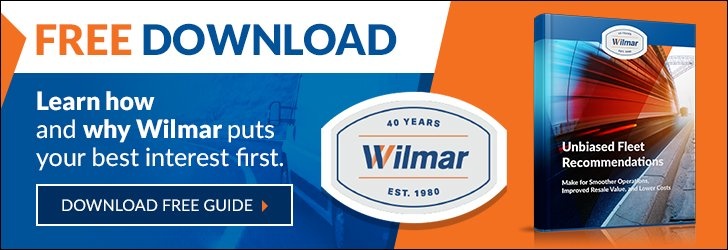.jpeg?width=1200&height=800&name=AdobeStock_479240607%20(1).jpeg)
In the competitive world of fleet management, retaining skilled drivers is a top priority for businesses, especially in industries like logistics, delivery, and ridesharing. High driver turnover can disrupt operations, increase training costs, and erode customer satisfaction.
Fleet leasing companies are stepping up to address this challenge by offering leasing benefits that enhance driver satisfaction, safety, and performance. From modern vehicles equipped with advanced technology to ergonomic designs and performance-based incentives, these benefits are helping clients retain drivers while strengthening partnerships with leasing providers.
The Driver Retention Challenge
Driver turnover is a persistent issue in fleet-based industries. Long hours, demanding schedules, and vehicle-related stress can lead to burnout, prompting drivers to seek better opportunities. For businesses, replacing drivers is costly—recruitment, onboarding, and lost productivity can quickly add up. Fleet leasing companies are uniquely positioned to support clients in tackling this issue by providing vehicles and services that improve the driver experience, making jobs more appealing and sustainable.
By offering benefits like modern vehicles, safety-focused technology, and data-driven incentives, leasing companies help clients create a work environment that drivers want to stay in. This not only reduces turnover but also positions leasing providers as valuable partners in operational success.
Modern Vehicles with Advanced Features
A key leasing benefit for driver retention is access to modern vehicles equipped with cutting-edge features. Fleet leasing companies can provide vehicles with Advanced Driver Assistance Systems (ADAS), such as lane departure warnings, automatic emergency braking, and adaptive cruise control. These technologies reduce driver stress by enhancing safety and simplifying navigation in challenging conditions, like urban traffic or long-haul routes.
For example, a delivery company leasing a fleet of vans with ADAS can offer drivers a safer, more comfortable driving experience, reducing fatigue and accident risks. Modern vehicles also often include amenities like climate control, adjustable seating, and infotainment systems, which improve driver comfort during long shifts. By leasing these vehicles, businesses can attract and retain drivers who value a high-quality work environment, without the capital investment of purchasing new fleets.
Ergonomic Designs for Driver Comfort
Driver comfort is critical for retention, especially for those spending hours behind the wheel. Leasing companies are responding by offering vehicles with ergonomic designs tailored to driver needs. Features like adjustable lumbar support, vibration-dampening seats, and intuitive dashboard layouts reduce physical strain and enhance focus.
For instance, a leasing company might provide a logistics client with trucks featuring ergonomic cabs designed for long-haul drivers, minimizing back pain and fatigue. These thoughtful designs demonstrate to drivers that their well-being is a priority, fostering loyalty. Leasing companies can further differentiate themselves by offering clients a range of vehicle options, allowing businesses to match vehicles to specific driver roles, such as urban delivery or regional transport.
Telematics-Driven Performance Incentives
Telematics systems, which track vehicle and driver data, are transforming how leasing companies support retention. By analyzing metrics like fuel efficiency, braking patterns, and route adherence, leasing companies can provide clients with insights to create performance-based incentives for drivers. These incentives reward safe and efficient driving, boosting morale and encouraging long-term commitment.
For example, a leasing company might use telematics to identify drivers who consistently achieve high fuel efficiency or avoid harsh braking. Clients can then offer bonuses or recognition programs based on this data, incentivizing drivers to stay with the company. Telematics also enables targeted training, helping drivers improve skills and feel supported in their roles. This data-driven approach not only improves retention but also reduces wear-and-tear costs, benefiting both clients and leasing providers.
Flexible Lease Terms for Driver Support
Leasing companies can further enhance retention by offering flexible lease terms that align with driver needs. For gig economy businesses or those with seasonal demand, short-term leases allow clients to provide drivers with vehicles during peak periods without long-term costs. This flexibility ensures drivers have access to reliable vehicles when work is available, reducing financial stress and turnover.
Additionally, leasing companies can offer all-inclusive packages that cover maintenance, insurance, and roadside assistance. For drivers, this eliminates the burden of unexpected repair costs or downtime, creating a more predictable and appealing job. For clients, these packages simplify fleet management, allowing them to focus on supporting their workforce.
Benefits for Clients and Leasing Companies
Leasing benefits designed for driver retention deliver significant advantages:
-
Reduced Turnover: Modern vehicles, ergonomic designs, and incentives create a positive work environment, encouraging drivers to stay.
-
Cost Savings: Lower turnover reduces recruitment and training expenses, while telematics-driven efficiency cuts fuel and maintenance costs.
-
Enhanced Safety: ADAS and telematics improve driver safety, reducing accident risks and liability.
-
Stronger Partnerships: Leasing companies offering retention-focused benefits build trust and loyalty with clients.
Challenges and Considerations
Implementing these benefits comes with challenges. Equipping fleets with ADAS or ergonomic features requires upfront investment, which may increase lease costs for clients. Leasing companies must balance these costs with competitive pricing to remain attractive to SMEs and startups. Data privacy is another concern, as telematics systems collect sensitive driver information. Clear policies and robust cybersecurity are essential to maintain trust.
Clients may also need guidance on using telematics data effectively for incentive programs. Leasing companies can address this by providing user-friendly dashboards or consulting services to help clients design retention strategies. Collaboration with vehicle manufacturers to source cost-effective, driver-focused vehicles can further enhance offerings.
The Future of Driver Retention in Fleet Leasing
As driver shortages and turnover continue to be industry challenges, leasing companies that prioritize retention-focused benefits will stand out. Emerging technologies, such as AI-driven driver coaching or autonomous vehicle integration, promise to enhance the driver experience further. For now, modern vehicles, ergonomic designs, and telematics-driven incentives are making a tangible difference.
By offering leasing benefits that prioritize driver satisfaction, fleet leasing companies are not just providing vehicles—they’re helping clients build loyal, productive workforces. For businesses, these solutions mean lower costs, happier drivers, and stronger operations. In the race to retain talent, leasing companies are driving success, one driver at a time.








